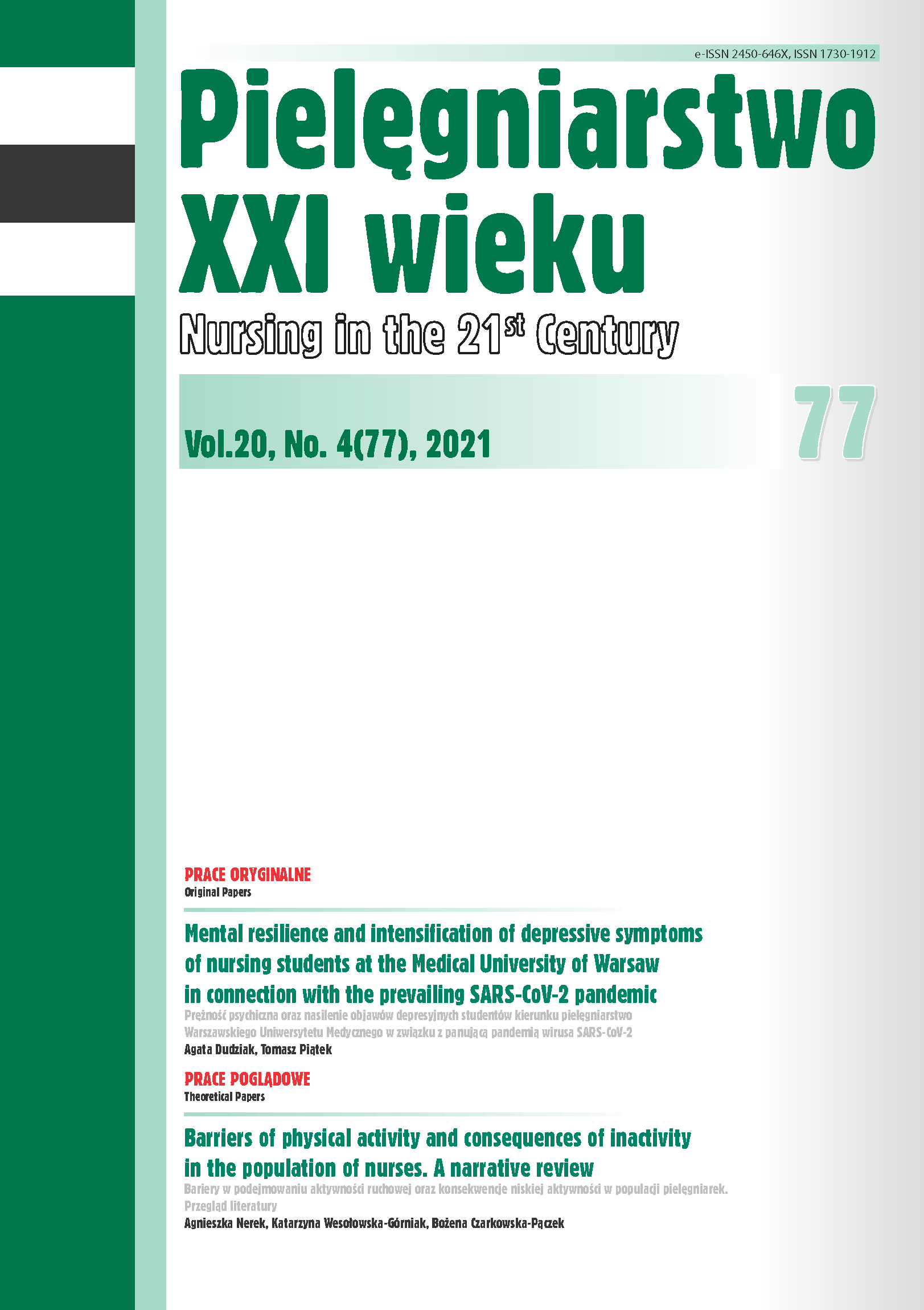Identyfikacja agresji wśród hospitalizowanych pacjentów wobec pielęgniarek za pomocą narzędzi pomiaru
DOI:
https://doi.org/10.2478/pielxxiw-2021-0035Słowa kluczowe:
pielęgniarka, agresja, narzędzia pomiarowe, pacjent, zakład opieki zdrowotnejAbstrakt
IDENTYFIKACJA AGRESJI WŚRÓD HOSPITALIZOWANYCH PACJENTÓW WOBEC PIELĘGNIAREK ZA POMOCĄ NARZĘDZI POMIARU
Cel pracy. Identyfikacja i porównanie wyników badań mających na celu określenie częstości występowania wśród hospitalizowanych pacjentów agresji wobec pielęgniarek przeprowadzonych za pomocą narzędzi pomiarowych: Skali Przemocy i Agresji Pacjentów (VAPS) oraz Skali Percepcji Rozpowszechnienia Agresji (POPAS).
Materiał i metody. Próba składała się z 1012 pielęgniarek z wybranych placówek opieki zdrowotnej w Czechach. Dane zbierano od czerwca do listopada 2018 r. Identyfikacji występowania agresji hospitalizowanych pacjentów wobec pielęgniarek dokonano za pomocą dwóch narzędzi pomiarowych: POPAS i VAPS. Oba narzędzia opisują określone formy agresywnego zachowania.
Wyniki. Zidentyfikowaliśmy bardzo wysoką częstość występowania agresji wśród hospitalizowanych pacjentów wobec pielęgniarek. 97% badanych spotkało się z różnymi przejawami i formami agresji ze strony pacjentów, 61,96% z agresją fizyczną (plucie, gryzienie, drapanie, szczypanie), a 76,4% - agresją werbalną. Stwierdzono istotną różnicę między wynikami uzyskanymi za pomocą POPAS i VAPS.
Wnioski. Za pomocą dwóch wiarygodnych narzędzi pomiarowych zidentyfikowaliśmy różne doświadczenia z agresją hospitalizowanych pacjentów wobec pielęgniarek w tej samej grupie respondentów, co wskazuje na problem porównania wyników częstości występowania agresji pacjentów wobec pielęgniarek zidentyfikowanych za pomocą różnych narzędzi pomiarowych.
Bibliografia
1. Rippon TJ. Aggression and violence in health care professions. Adv. Nurs. 2000; 31(2): 452-460.
2. Hahn S, Müller M, Needham I, et al. Factors associated with patient and visitor violence experienced by nurses in general hospitals in Switzerland: a cross-sectional survey. J. Clin. Nurs. 2010; 19(23-24): 3535-3546.
3. Moghadam MF, Pazargadi M, Khoshknab MF. Iranian Nurses’ Experiences of Aggression in Psychiatric Wards: A Qualitative Study. Issues Ment. Health Nurs. 2013; 34(10): 765-7134.
4. Angland S, Dowling M, Casey D. Nurses’ perceptions of the factors which cause violence and aggression in the emergency department: A qualitative study. Int. Emerg. Nurs. 2014; 22(3): 134-139.
5. Lepiešová M, Tomagová M, Bóriková I, et al. Experience of nurses with in-patient aggression in the Slovak Republic. Central European Journal of Nursing and Midwifery. 2015; 6(3): 306-312.
6. Sun P, Zhang X, Sun Y, et al. Workplace violence against health care workers in North Chinese hospitals: A cross-sectional Survey. Int. J. Environ. Res. Public Health. 2017; 14(1): 96.
7. El-Hneiti M, Shaheen AM, Salameh A, et al. An explorative study of workplace violence against nurses who care for older people. Nurs. Open. 2019; 7(1): 285-293.
8. Kowalczuk K, Krajewska-Kułak E. Patient aggression towards different professional groups of healthcare workers. Ann. Agric. Environ. Med. 2017; 24(1): 113-116
9. Gillespie GL, Pekar B, Byczkowski TL, et al. Worker, worplace, and community/ environmetal risk factors for workplace violence in emergency departments. Arch. Environ. Occup. Health. 2017; 72(2): 79-86.
10. Dehghan-Chaloshtari S, Ghoudousi A. Factors and characteristics of Workplace Violence Against Nurses: A study in Iran. JIV. 2020; 35(1-2); 496-509.
11. Iennaco JD, Dixon J, Whittemore R, et al. Measurement and monitoring of health care worker aggression exposure. Online J. Issues Nurs. 2013; 18(1): 3.
12. Arnetz JE. The Violent Incident Form (VIF): A practical instrument for the registration of violent incidents in the health care workplace. Work & Stress. 1998; 12(1): 17-28.
13. Yudofsky SC, Silver JM, Jackson W, et al. The Overt Aggression Scale for the objective rating of verbal and physical aggression. Am. J. Psychiatry. 1986; 143(1): 35-39.
14. Oud N. The Percerptions od Prevalence Of Aggresion Scale (POPAS). 2001. https:// w w w.r esearchgate.ne t /prof ile/Nico _O ud/public ation/2701598 49_The_ Perception_of_Prevalence_of_Aggression_Scale_POPAS_Questionnaire/ links/54a177900cf256bf8baf71c1/The-Perception-of-Prevalence-of-AggressionScale-POPAS-Questionnaire.pdf [cited 10.11.2020].
15. Lepiešová M, Čap J, Žiaková K, et al. Incidence of Patient’s Aggression against Nurses – Psychometric Properties of Instrument. Ošetrovateľstvo: teória, výskum, vzdelávanie. 2012; 2(1): 26-32.
16. Hahn S, Müller M, Needham I, et al. Measuring patient and visitor violence in general hospitals: feasibility of the SOVES-G-R, internal consistency and construct validity of the POAS-S and the POIS. J. Clin. Nurs. 2011; 20(17-18): 2519-2530.
17. International Labour Office ILO, International Council of Nurses ICN, World Health Organization WHO, & Public Services International PSI. Workplace Violence in the Health Sector Country Case Studies Research Instruments Survey Questionnaire English. 2003. http://www.who.int/violence_injury_prevention/violence/interpersonal/en/ WVquestionnaire.pdf [cited 08.10.2020].
18. Taylor JL, Rew L. A systematic review of the literature: workplace violence in the emergency department. J. Clin. Nurs. 2011; 20(7-8): 1072-1085.
19. Pekurinen V, Välimäki M, Virtanen M, et al. Work Stress and Satisfaction with Leadership Among Nurses Encountering Patient Aggression in Psychiatric Care: A Cross-Sectional Survey Study. Adm. Policy Ment. Health. 2019; 4 6(3): 368-379.
20. Zhao SH, Shi Y, Sun ZN, et al. Impact of workplace violence against nurses’ thriving at work, job satisfaction and turnover intention: A cross sectional study. J. Clin. Nurs. 2018; 27(13-14): 2620-2632.
21. Muñoz IG, Zaragoza PL, Hernández JAR, Jiménez-Barbero JA. Exposure to service user violence and job satisfaction among nursing staff in public hospitals in Murcia Region. An. Sist. Sanit. Navar. 2018; 41(2): 181-189.
22. Nijman HLI, Bowers L, Oud N, et al. Psychiatric Nurses’ Experiences with Inpatient Aggression. Aggressive Behavior. 2005; 31(3): 217-227.
23. Yenealem DG, Woldegebriel MK, Olana AT, et al. Violence et work: determinants and prevalence among health care workers, northwest Ethiopia: an institutional based cross sectional study. Ann Occup Environ Med. 2019; 31: 8.
24. Dimunová L, Žemličková A. Patients aggression towards nurses on psychiatric war. Ošetrovateĺstvo: teória, výzkum, vzdelávanie. 2019; 9(1): 31-35.
25. Swain N, Gale Ch, Greenwood R. Patient aggression experienced by staff in public hospital setting. N Z Med J. 2014; 127(1394): 10-18.
Pobrania
Opublikowane
Numer
Dział
Licencja
Prawa autorskie (c) 2021 Autorzy

Utwór dostępny jest na licencji Creative Commons Uznanie autorstwa – Użycie niekomercyjne – Bez utworów zależnych 4.0 Międzynarodowe.




